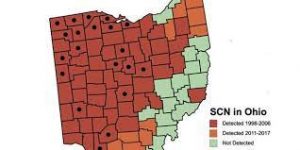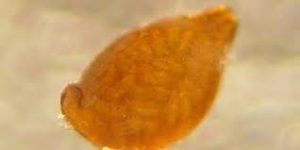Fall SCN Sampling
By Dusty Sonnenberg, CCA, Ohio Field Leader, a project of the Ohio Soybean Council and soybean check-off.
Fall is a great opportunity for soil testing. It is also an excellent opportunity to scout and soil test for soybean cyst nematodes (SCN). Soybean Cyst Nematode soil sample collecting can be done after soybean harvest, or in a non-host crop, or anytime during the season in the soybean crop root zone.  Soybean Cyst Nematode is the number one contributor to yield loss in soybean crops nationwide, causing an estimated $1.2 billion dollars in damage annually. This pest has been detected in 71 of the 88 counties in Ohio, with the highest concentrations located in the northwestern part of the state.
Soybean Cyst Nematode is the number one contributor to yield loss in soybean crops nationwide, causing an estimated $1.2 billion dollars in damage annually. This pest has been detected in 71 of the 88 counties in Ohio, with the highest concentrations located in the northwestern part of the state.
There are two ways to scout for SCN. The first is to dig the roots and specifically look for the female nematodes. In the late summer and fall they will appear as a “string of pearls” on the roots, which is the female nematode forming the cyst on the root as her body is filled with eggs.

The second way to scout is to collect soil samples and send them for testing. It is recommended to collect 15-20 1-inch-diameter samples, 8 inches deep for every 20 acres. The cores should be mixed together thoroughly and submitted to the SCN testing lab.
When collecting soil samples, there are three approaches. The first is to collect soil cores using a zigzag pattern across the field. The second option is to collect soil cores from logical management areas or zones in the field (also in a zigzag pattern). The third is to collect soil cores from high-risk areas in the field where SCN might first be discovered, such as near buildings or equipment storage, along fence lines, in field entrances, areas of high pH, areas that tend to flood, and consistently low yielding areas of the field.
For more information visit https://www.thescncoalition.com/application/files/5615/1871/9413/scouting-and-soil-testing.pdf